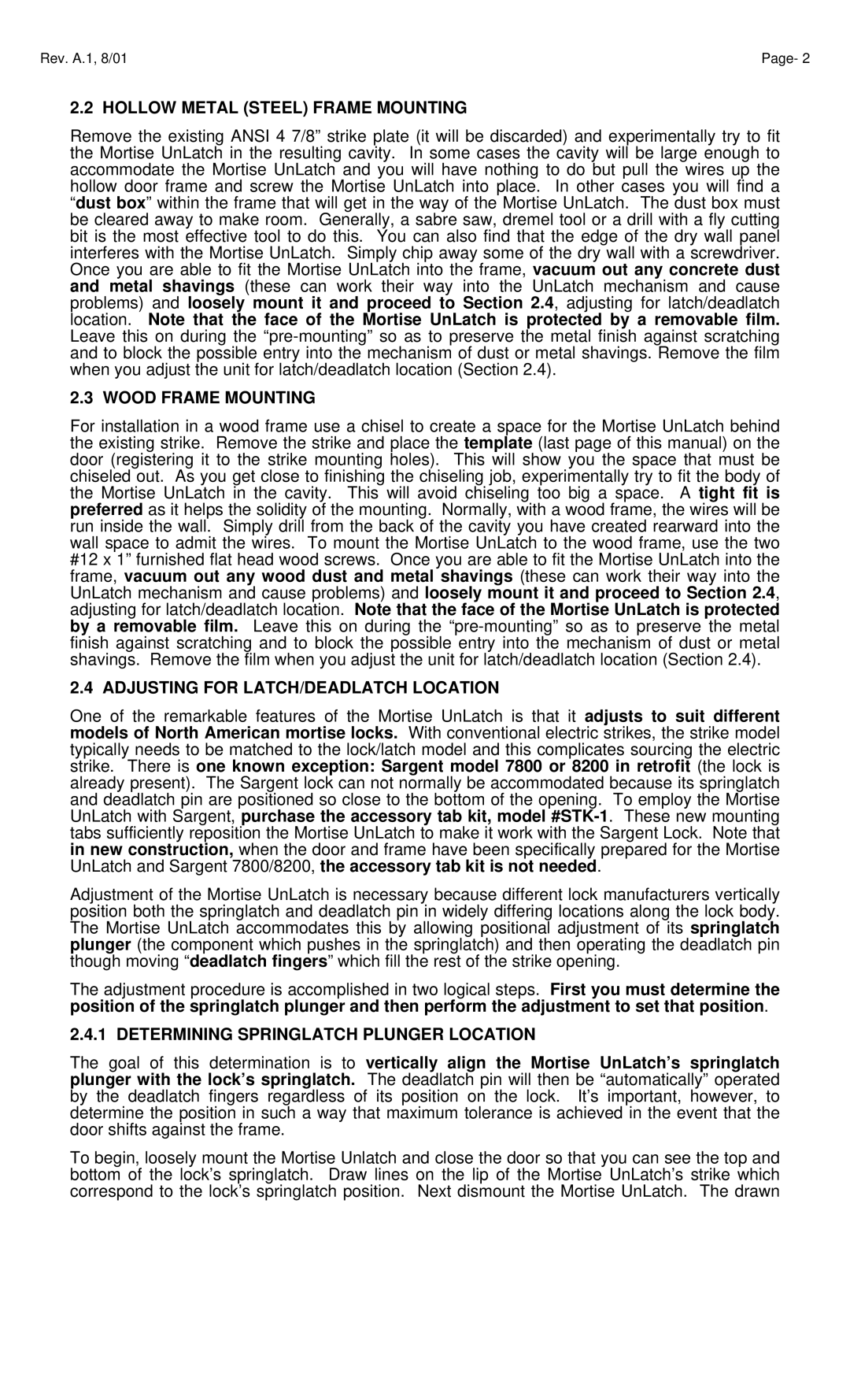2.2 HOLLOW METAL (STEEL) FRAME MOUNTING
Remove the existing ANSI 4 7/8” strike plate (it will be discarded) and experimentally try to fit the Mortise UnLatch in the resulting cavity. In some cases the cavity will be large enough to accommodate the Mortise UnLatch and you will have nothing to do but pull the wires up the hollow door frame and screw the Mortise UnLatch into place. In other cases you will find a “dust box” within the frame that will get in the way of the Mortise UnLatch. The dust box must be cleared away to make room. Generally, a sabre saw, dremel tool or a drill with a fly cutting bit is the most effective tool to do this. You can also find that the edge of the dry wall panel interferes with the Mortise UnLatch. Simply chip away some of the dry wall with a screwdriver. Once you are able to fit the Mortise UnLatch into the frame, vacuum out any concrete dust and metal shavings (these can work their way into the UnLatch mechanism and cause problems) and loosely mount it and proceed to Section 2.4, adjusting for latch/deadlatch location. Note that the face of the Mortise UnLatch is protected by a removable film. Leave this on during the “pre-mounting” so as to preserve the metal finish against scratching and to block the possible entry into the mechanism of dust or metal shavings. Remove the film when you adjust the unit for latch/deadlatch location (Section 2.4).
2.3 WOOD FRAME MOUNTING
For installation in a wood frame use a chisel to create a space for the Mortise UnLatch behind the existing strike. Remove the strike and place the template (last page of this manual) on the door (registering it to the strike mounting holes). This will show you the space that must be chiseled out. As you get close to finishing the chiseling job, experimentally try to fit the body of the Mortise UnLatch in the cavity. This will avoid chiseling too big a space. A tight fit is preferred as it helps the solidity of the mounting. Normally, with a wood frame, the wires will be run inside the wall. Simply drill from the back of the cavity you have created rearward into the wall space to admit the wires. To mount the Mortise UnLatch to the wood frame, use the two #12 x 1” furnished flat head wood screws. Once you are able to fit the Mortise UnLatch into the frame, vacuum out any wood dust and metal shavings (these can work their way into the UnLatch mechanism and cause problems) and loosely mount it and proceed to Section 2.4, adjusting for latch/deadlatch location. Note that the face of the Mortise UnLatch is protected by a removable film. Leave this on during the “pre-mounting” so as to preserve the metal finish against scratching and to block the possible entry into the mechanism of dust or metal shavings. Remove the film when you adjust the unit for latch/deadlatch location (Section 2.4).
2.4 ADJUSTING FOR LATCH/DEADLATCH LOCATION
One of the remarkable features of the Mortise UnLatch is that it adjusts to suit different models of North American mortise locks. With conventional electric strikes, the strike model typically needs to be matched to the lock/latch model and this complicates sourcing the electric strike. There is one known exception: Sargent model 7800 or 8200 in retrofit (the lock is already present). The Sargent lock can not normally be accommodated because its springlatch and deadlatch pin are positioned so close to the bottom of the opening. To employ the Mortise UnLatch with Sargent, purchase the accessory tab kit, model #STK-1. These new mounting tabs sufficiently reposition the Mortise UnLatch to make it work with the Sargent Lock. Note that in new construction, when the door and frame have been specifically prepared for the Mortise UnLatch and Sargent 7800/8200, the accessory tab kit is not needed.
Adjustment of the Mortise UnLatch is necessary because different lock manufacturers vertically position both the springlatch and deadlatch pin in widely differing locations along the lock body. The Mortise UnLatch accommodates this by allowing positional adjustment of its springlatch plunger (the component which pushes in the springlatch) and then operating the deadlatch pin though moving “deadlatch fingers” which fill the rest of the strike opening.
The adjustment procedure is accomplished in two logical steps. First you must determine the position of the springlatch plunger and then perform the adjustment to set that position.
2.4.1 DETERMINING SPRINGLATCH PLUNGER LOCATION
The goal of this determination is to vertically align the Mortise UnLatch’s springlatch plunger with the lock’s springlatch. The deadlatch pin will then be “automatically” operated by the deadlatch fingers regardless of its position on the lock. It’s important, however, to determine the position in such a way that maximum tolerance is achieved in the event that the door shifts against the frame.
To begin, loosely mount the Mortise Unlatch and close the door so that you can see the top and bottom of the lock’s springlatch. Draw lines on the lip of the Mortise UnLatch’s strike which correspond to the lock’s springlatch position. Next dismount the Mortise UnLatch. The drawn
